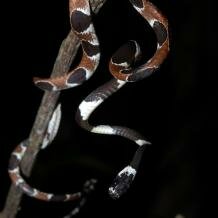Topic: Snail eating: an asymmetric diet
Snails may not be everyone's first choice on the menu but several distinct colubrid snakes have evolved expert techniques for gorging on these nutritious gastropods.
 Snails may not be everyone’s first choice on the menu but several distinct colubrid snakes have evolved expert techniques for gorging on these nutritious gastropods. Southeast Asian pareatine snakes (e.g. Pareas iswasaki) and neo-tropical dipsadine snakes (e.g. Dipsas) both have asymmetrical mandibles (lower jaws) with many more teeth on the right than the left side. The right and left mandibles are inserted into right-coiling snail shells and then repeatedly retracted in alternation, delicately extracting the snail’s soft body. In an incredible instance of convergence, not only the pareatine and dipsadine snakes, but also certain insectivorous beetle larvae have asymmetrical mandibles for snail predation. Again, right-coiling snails are preferred so that, unusually, atypical left-coiling variants gain a selective advantage where these predators abound.
Snails may not be everyone’s first choice on the menu but several distinct colubrid snakes have evolved expert techniques for gorging on these nutritious gastropods. Southeast Asian pareatine snakes (e.g. Pareas iswasaki) and neo-tropical dipsadine snakes (e.g. Dipsas) both have asymmetrical mandibles (lower jaws) with many more teeth on the right than the left side. The right and left mandibles are inserted into right-coiling snail shells and then repeatedly retracted in alternation, delicately extracting the snail’s soft body. In an incredible instance of convergence, not only the pareatine and dipsadine snakes, but also certain insectivorous beetle larvae have asymmetrical mandibles for snail predation. Again, right-coiling snails are preferred so that, unusually, atypical left-coiling variants gain a selective advantage where these predators abound.
Still within the reptiles we find another highly adapted snail-eater and with it another exemplary case of convergence. The Australian pink-tongued skink (Cyclodomorphus gerrardii) is a rainforest-dwelling lizard with a pair of large ‘hammer’ teeth for cracking snail shells. Within the same geographic region fossils of a Miocene marsupial (Malleodectes) have been found whose dentition is all but identical to Cyclodomorphus. It seems that both animals preyed on rainforest snails in the same way, and in the increasing competition resulting from climate change the lizards, in the end, came up trumps.
Cite this web page
Map of Life - "Snail eating: an asymmetric diet"
https://mapoflife.org/topics/topic_591_snail-eating-an-asymmetric-diet/
March 3, 2021

